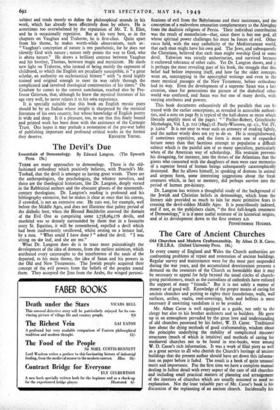The Care of Ancient Churches
IN every county of England and Wales the Church authorities are confronting problems of repair and restoration of ancient buildings. Regular survey and maintenance were for the most part suspended during the war years, and the accumulated deterioration presents a demand on the resources of the Church so formidable that it may be necessary to appeal for help beyond the usual circles of church- going parishioners, much as the custodians of cathedrals have enlisted the support of many "friends." But it is not solely a matter of money or of good will. Knowledge of the proper means of caring for ancient churches and putting to rights their foundations, walls, wall surfaces, arches, vaults, roof-coverings, bells and belfries is most necessary if unwitting vandalism is to be avoided.
Mr. Alban Caroe is well equipped as a guide, not only to the clergy but also to his brother architects and to builders. He grew up in an atmosphere pervaded by the great love and understanding of old churches possessed by his father, W. D. Caroe. Traditional lore about the dying methods of good craftsmanship, wisdom about the principles underlying the stability of complicated masonry structures (much of which is intuitive) and methods of caring for mediaeval churches not to be found in text-books, were among W. D. Caroe's rich information. It was a work of filial piety as well as a great service to ail who cherish the Church's heritage of ancient buildings that the present author should have set down this informa- tion on paper before it faded. The result is a book of quite unusual merit and importance. For the first time we have a complete manual dealing in fullest detail with every aspect of the care of old churches and including small practical matters of planning and arrangement of the interiors of churches which are usually assumed to need no explanation. Not the least valuable parr of Mr. Caroe's book is his discussion of the replanning of an ancient church. Incidentally his reflections on the disdain in which our grandfathers held Georgian work—" Georgian boxes "—which we now admire, perhaps too un- critically, should teach us to think twice before abolishing what we now call a "blatant Victorian excrescence."
This is virtually a case-book of operations on ancient buildings. The ample details, diagrams, drawings and photographs put the reader in complete possession of all relevant facts. The author has a deep love of his subject and erudition which he bears modestly. It ranks immediately as a standard work in a realm of study long in need of such authoritatively marshalled and interpreted information.
C. B. MORTLOCK.











































 Previous page
Previous page